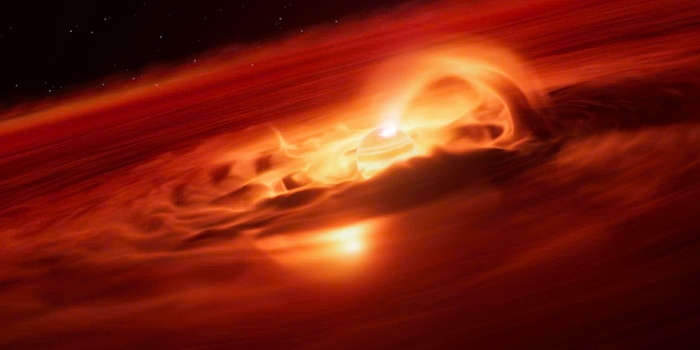
Vagabond planet grows rapidly
There are planets in the universe that wander around without stars. One of them is rapidly increasing in mass, as observations show.
In the vastness of the universe, there are probably billions of planets that do not belong to any solar system and wander lonely through space. These vagabonds - known in English as «rogue planets» and in German simply as «objects of planetary mass» - are difficult to observe, but the size of known objects ranges from the size of the Earth to several times the mass of Jupiter. A particularly impressive example is Cha 1107-7626 from the constellation Chamaeleon (Latin: Chamaeleon, abbreviated: Cha) at a distance of 620 light years: According to the findings of a working group led by Víctor Almendros-Abad from the Palermo Observatory, the exoplanet has about five to ten times the mass of Jupiter, but is also growing at a record-breaking rate.
Observations with the Very Large Telescope (VLT) of the European Southern Observatory (ESO) show that this vagabond planet is absorbing gas and dust from its surroundings at a rate of six billion tonnes per second, thereby increasing in mass at an extreme rate. This is the strongest growth rate ever observed in such a solitary planet or in a planet at all, writes the team in a press release.
Cha 1107-7626 is therefore still in the midst of its formation and growth, which is fuelled by the surrounding accretion disc of gas and dust. However, the increase is not uniform, but occurs in phases, as the data show. In August 2025, the planet was accumulating matter around eight times faster than just a few months earlier: around six billion tonnes per second, which is almost equivalent to the mass of the comet 67P/Churyumov-Gerasimenko, which was the target of a European research mission for a time in the 2010s.
In addition to the data from the VLT, Almendros-Abad and Co. also used other data from the James Webb telescope. This allowed them to collect the spectra before and during the accretion outburst, when the planet was growing particularly quickly. Magnetic activity obviously played a strong role in this, which had previously only been observed in stars. The planetary objects, which are relatively low in mass in comparison, may therefore still have strong magnetic fields that drive such accretion events. Spectroscopic images taken at the time of the outburst also suggest that the chemical composition of the disc around the planet changed: Water vapour could be detected during the spectacle, but not before. This phenomenon had also previously only been observed in stars, but not in planets of any kind.
«This discovery blurs the boundary between stars and planets and allows us a glimpse into the earliest developmental phases of solitary planets», says astronomer Belinda Damian from the University of St Andrews, who was involved in the study. It is still unclear how the vagabonds form in the first place, for example whether they are ejected from their original star system. Or whether they form independently in space by gradually accumulating matter like stars. Cha 1107-7626 suggests that the latter is the case for at least some of these objects.
Spectrum of Science
We are partners of Spektrum der Wissenschaft and want to make well-founded information more accessible to you. Follow Spektrum der Wissenschaft if you like the articles.
Original article on Spektrum.de
Experts from science and research report on the latest findings in their fields – competent, authentic and comprehensible.
From the latest iPhone to the return of 80s fashion. The editorial team will help you make sense of it all.
Show all